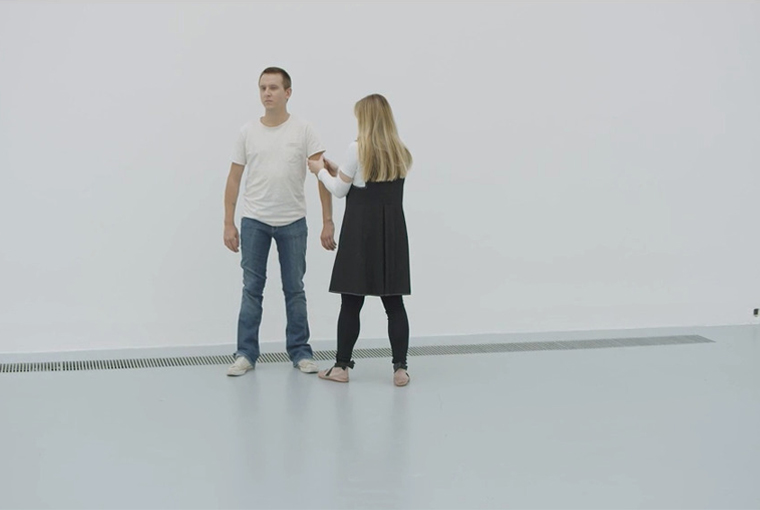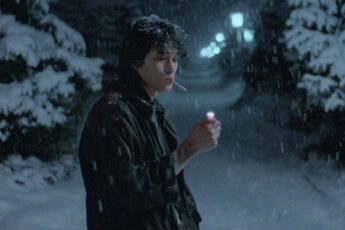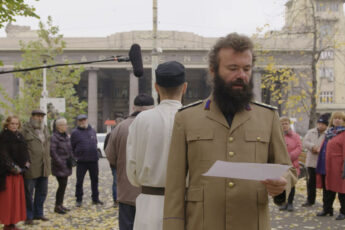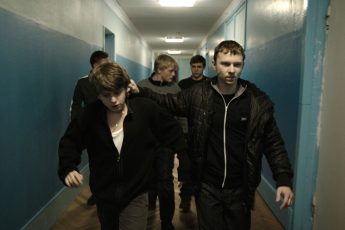
Przemysław Branas’ video created for last year’s VIEWS 2017 exhibition at the Zachęta National Gallery in Warsaw develops an oneiric collage of motifs, sites and situations that portrays the continuity of violence at the intersection of art and politics. Consisting – for the most part – of a single shot, the film begins by returning to a 1900 oil painting of one of the greatest Polish men of letters, Stefan Żeromski. Yet, just as important as the portrayed writer, is the maker of the painting: Eligiusz Niewiadomski (1869–1923), an artist, a post-WWI nationalist, and – last but not least – an assassin. On 16 December 1922, at an exhibition opening at the Zachęta – the very same place where Branas’ film premiered – Niewiadomski fatally shot the first president of independent Poland, Gabriel Narutowicz.
The camera pans unhurriedly around an exhibition room with a museum guard, while the artist himself traverses it slowly, passing by two women engaged in conversation (Zachęta director Hanna Wróblewska and Views 2017 exhibition curator Dorota Monkiewicz), one of whom confronts us with a mysterious gaze. We slowly begin to feel tension building up as their eyes turn towards a rifleman aiming at the artist in the corner of the room. Then the presence of yet another armed man is revealed, whose attire and posture bear a striking resemblance to the iconic image of Turkish police officer Mevlüt Mert Altıntaş taken moments after he had assassinated the Russian ambassador to Turkey Andrei Karlov at an art exhibition opening in Ankara, on the 19th of December 2016. The Turkish gunman fires no shots here, yet as the film draws to a close, we realize that someone will indeed get hurt. The artist patiently yet tensely awaits a carefully measured shot from the rifle, which is finally administered. As Chris Burden’s performance Shoot from 1971 is thus re-enacted, the Zachęta building once again becomes a site of violence.
In Branas’ film, this re-enactment becomes embedded in a highly peculiar frame that seems to weigh heavily on its meaning. The dramatic act forms part of a broader sequence that shifts us back and forth in time from 1922, to 2016, and back to 1971, sending us across the globe and juggling motifs in a way that seems to convey that nothing is ever too far-removed to co-occur. Such a logic, or lack thereof, brings to mind the structure of a dream, in which – according to Freud – a range of mechanisms are at play at the interface between its manifest and latent content.1 Offering, according to Freud, an insight into the subconscious, events in dreams do not take direct and immediate forms, but become mediated through mysterious references generated with the mechanisms of condensation, dramatization, and – importantly for Branas’ re-enactment – displacement, in which “these very dream thoughts which … have a claim to the greatest importance are either not present at all in the dream content, or are represented by some remote allusion in some obscure region of the dream.”2
As we approach the film from this perspective, we may feel compelled to ask: is it really only Burden’s action that is being re-enacted here? Or is his act merely part of the manifest content that is in fact underpinned by the actual, deeper-level event? Perhaps a different act of violence committed in the same place and hinted at only remotely through a vague reference to Eligiusz Niewiadomski?
In the curatorial text of the exhibition History Will Repeat Itself. Strategies of Re-enactment in Contemporary Art – shown at Berlin’s KW and Dortmund’s HMKV in 2007 and 2008, curator Inke Arns differentiates between “historical re-enactments” and “artistic re-enactments”, defining the former as “performative re-stagings of historic situations” that operate through “imagining oneself into another time and having nothing (or little) to do with the present”. This mechanism is altogether different, Arns argues, from an “artistic re-enactment” that addresses “events (often traumatic ones) that are viewed as very important for the present”.3 Even if the question of relevance to the present is set aside, the Zachęta performance filmed in Branas’ work occupies an interesting position within this conceptual framework. In principal, it is indeed a faithful reconstruction of Burden’s action, which brings it closer to the realm of historical re-enactment. Yet, when approached as a re-enactment of Narutowicz’s death via the logic of an implicit correspondence between the manifest and latent contents of a dream, the film appears to fit neatly in the realm of art and its re-enactment devices. The assassination appears to be re-staged in the same edifice and with the same kind of weapon, but is arrived at via a temporal and historical detour – as a re-enactment of another performance that happened to be as violent (although not as deadly). Thus, it provides quite a specific mode of artistic re-enactment – one that operates through Freud’s concept of “displacement”. What therefore emerges in Branas’ film is a paradoxical situation that is simultaneously a historical re-enactment of an artist’s work, and an artistic re-enactment of a historical event. Interestingly, this is not the only way in which art enters the historical equation in this work. Shots fired at artists and at politicians become conflated, hence the quite direct evocation of the recent assassination of the Russian ambassador in an Ankara gallery. The art institution is thus foregrounded as a site of violent acts that shape history (whether it is the history of art or politics) and underscored in its important political dimension that spans decades.
In her differentiation between modes of re-enactment, Arns insists on the connection that “artistic re-enactments” maintain with the present. “Here”, she writes “the reference to the past is not history for history’s sake; it is about the relevance of what happened in the past for the here and now. Thus one can say that artistic re-enactments are not an affirmative confirmation of the past; rather, they are questionings of the present through reaching back to historical events that have etched themselves indelibly into the collective memory.”4 What would be the connection between the present and the re-enactment of Narutowicz’s death, as staged by artistic means of an intricate structure of displacement? How would it question the present any more than the re-enactment of Burden’s work?
To shed light on this connection, let us take a look at the assassination from a more historical perspective. In Primed for Violence, a thorough analysis of that tragic event, historian Paul Brykczyński indicates that although Niewiadomski acted alone and was initially viewed as a madman because of his attack, his action came to epitomize a much more profound conflict enveloping the newly independent Polish state across the political spectrum. The opposing actors that clashed over the course of that struggle were the far-right National Democracy movement and the followers of Marshal Józef Piłsudski, a key statesman in post-WWI Poland. As Brykczyński writes, their conflict “was long-standing and bitter, and involved … fundamentally different readings of Polish history and identity”.5 As a presidential candidate nominated by Piłsudski, Narutowicz clearly represented one of those opposing political visions, thus antagonizing the other – the National Democracy. What sealed his role as the focal figure of that profound conflict was the support of national minorities that earned him the reputation of being a “president elected by Jews”. In an era rife with antisemitism, the Jewish question was central to the conflict between political forces in Poland, with Jews depicted by right-wing nationalists as a principal enemy of the state. “The president’s vicious repudiation by the right,” Brykczynski argues, “and his ultimate murder signaled the rejection of the minorities, and especially Jews from the national polity by a large and vocal part of the electorate.”6
Narutowicz’s death was therefore not “an accident of history”,7 an act committed by a lone wolf, but a brutal manifestation of a paradigmatic rift in Polish politics and society, and an “important, perhaps pivotal, event in the transformation of the discourse of the nation in Poland”.8 As such, its significance stretches well beyond 1922 and even beyond the interwar period, since the division that the assassination so poignantly marked, has kept haunting the nation and has been returning under many different guises. It is perhaps no coincidence that Branas shot his film in 2017, two years after the victory of the right-wing party Law and Justice in Poland’s parliamentary elections, at a time when its politico-social agenda had crystallized. Based on an understanding of the nation as a homogeneous community bound by a specific, exclusionary understanding of patriotism, by Catholic faith and social conservatism, the rise of the current Polish right-wing government echoes the paradigmatic divisions that polarized the political scene in the interwar period.9 What is thus revived is the very conflict about the understanding of the nation that Brykczynski situates at the root of Narutowicz’s assassination – the conflict about “imagining the imagined community”.10
The assassination of Narutowicz became a crucial development in the articulation of the ongoing political and social rift. Yet, given the haunting nature of the violence that this conflict engenders, it may also be seen as a traumatic event suffered by the Polish community. The traumatized collective subject may have survived violence, yet never came to fully confront or understand it. It therefore always subconsciously anticipates its traumatic return through as yet unknown iterations. The conflict that erupted at the Zachęta in 1922 continues to haunt the community, which acts it out through a mechanism that Cathy Caruth defined after Freud as an “unwitting reenactment of an event that one simply cannot leave behind”.11 Using the sublimated frames of the art institution and the performance art idiom, Branas stages such a return in his work in which traumatic violence becomes acted out. His artistic “reenactment through displacement” addresses both the trauma of the interwar period, and its powerful returns.
Untitled is highly representative of the overall mode of engagement with history and politics represented by the artist, who wrote about his film: “Aesthetization is a political tool, because it enables the mobilization of far more unconscious or repressed contents and has a greater potential of activizing the spectator than an ostentatious construction of a political language as such”. Using an approach that is affective rather than discursive, and aesthetic rather than publicistic, Branas develops an idiom of engagement with troubled history that continues to weigh heavily on our here and now, thus lending his statements a powerful political dimension in and for the present.




Leave a Comment